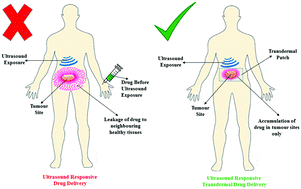当前位置:
X-MOL 学术
›
J. Mater. Chem. B
›
论文详情
Our official English website, www.x-mol.net, welcomes your
feedback! (Note: you will need to create a separate account there.)
Temperature and ultrasound sensitive gatekeepers for the controlled release of chemotherapeutic drugs from mesoporous silica nanoparticles†
Journal of Materials Chemistry B ( IF 6.1 ) Pub Date : 2017-11-29 00:00:00 , DOI: 10.1039/c7tb02292a T. S. Anirudhan 1, 2, 3, 4, 5 , Anoop S. Nair 1, 2, 3, 4, 5
Journal of Materials Chemistry B ( IF 6.1 ) Pub Date : 2017-11-29 00:00:00 , DOI: 10.1039/c7tb02292a T. S. Anirudhan 1, 2, 3, 4, 5 , Anoop S. Nair 1, 2, 3, 4, 5
Affiliation

|
With the advent of smart biomaterials, environmental stimuli have always been the trigger for targeted drug delivery. Conventional routes of drug administration suffer from serious drawbacks like first pass metabolism, less patient compliance and the requirement of trained personnel. Of the many well-established non-conventional routes, transdermal drug delivery systems (TDDSs) seem to be promising as they do not enter directly into the bloodstream and hence, side effects can significantly be reduced. Researchers around the world are trying to incorporate environmental sensitivity into TDDSs. Herein, we report the design and fabrication of a dual sensitive TDDS: (tetrahydropyranyl methacrylate-co-amino ethyl methacrylate)-grafted-mesoporous silica nanoparticles, (THPMA-co-AEMA)-g-MSNs, that could simultaneously sense temperature and an external stimulus – ultrasound (US). Temperature sensitivity was imparted by the conformational changes adopted by the system above and below the lower critical solution temperature (LCST). Below the LCST (4 °C), the polymer would exist as linear chains allowing drug molecules to enter the mesopores of silica, and at physiological temperatures the copolymer collapses preventing premature drug leakage. This sensitivity could be complemented by the inclusion of mechanophores like tetrahydropyran (THP), which could cleave bonds on exposure to US. At physiological temperatures, the TDDS can be placed at malignant sites and on US exposure, the chemotherapeutic agents could be leached out, resulting in better targeting, efficient drug release and minimal side effects. US can act as a potential penetration enhancer making it ideal even for targeting internal organs. All reaction procedures were monitored with the aid of FTIR, XRD, 1H NMR and FE-SEM techniques. Temperature sensitivity was analysed by encapsulating 5-flurouracil (5-FU) and analysing with a UV-Visible spectrophotometer. US sensitivity was monitored as a function of scattering light intensity. Pore opening and closure was verified by nitrogen adsorption isotherms. The dual responsiveness of the material was confirmed by confocal images of the sample before and after exposure to US. The physiological acceptance and practical efficacy of the material in real life situations were confirmed by histological studies on rat skin, MTT assay in HeLa cell lines and in vivo CAM assay. The results suggest the potential applicability of the material in site selective transdermal delivery of chemotherapeutic drugs.
中文翻译:

温度和超声敏感的看门人,用于从中孔二氧化硅纳米颗粒中控制释放化疗药物†
随着智能生物材料的出现,环境刺激一直是靶向药物递送的触发因素。常规的药物给药途径具有严重的缺点,例如首过代谢,患者依从性降低以及需要训练有素的人员。在许多公认的非常规途径中,透皮给药系统(TDDS)似乎很有希望,因为它们不直接进入血液,因此可以大大减少副作用。世界各地的研究人员正在尝试将环境敏感性纳入TDDS。在本文中,我们报道了双敏感TDDS的设计和制造:(四氢吡喃基甲基丙烯酸酯共-氨基乙基甲基丙烯酸酯) -接枝-中孔性的二氧化硅纳米粒子,(THPMA-共-AEMA)-g-MSN,可以同时感测温度和外部刺激-超声波(US)。温度敏感性是由系统在较低的临界溶液温度(LCST)之上和之下所采用的构象变化赋予的。低于LCST(4°C),聚合物将以线性链形式存在,允许药物分子进入二氧化硅的介孔,并且在生理温度下,共聚物会崩溃,从而防止药物过早泄漏。这种敏感性可以通过加入诸如四氢吡喃(THP)之类的机制而得到补充,该机制可以在暴露于美国时裂解键。在生理温度下,TDDS可以放置在恶性部位,在美国暴露时,可以浸出化学治疗剂,从而实现更好的靶向性,有效的药物释放和最小的副作用。美国可以充当潜在的渗透促进剂,即使是针对内部器官的理想选择。借助FTIR,XRD,1 H NMR和FE-SEM技术。通过封装5-氟尿嘧啶(5-FU)并使用紫外可见分光光度计进行分析,以分析温度敏感性。监测US灵敏度作为散射光强度的函数。通过氮吸附等温线验证孔的打开和闭合。通过在暴露于US之前和之后的样品共聚焦图像,可以确认材料的双重响应性。通过在大鼠皮肤上的组织学研究,HeLa细胞系中的MTT分析和体内CAM分析,证实了该材料在现实生活中的生理学接受性和实际功效。结果表明该材料在化学治疗药物的位置选择性透皮递送中的潜在适用性。
更新日期:2017-11-29
中文翻译:

温度和超声敏感的看门人,用于从中孔二氧化硅纳米颗粒中控制释放化疗药物†
随着智能生物材料的出现,环境刺激一直是靶向药物递送的触发因素。常规的药物给药途径具有严重的缺点,例如首过代谢,患者依从性降低以及需要训练有素的人员。在许多公认的非常规途径中,透皮给药系统(TDDS)似乎很有希望,因为它们不直接进入血液,因此可以大大减少副作用。世界各地的研究人员正在尝试将环境敏感性纳入TDDS。在本文中,我们报道了双敏感TDDS的设计和制造:(四氢吡喃基甲基丙烯酸酯共-氨基乙基甲基丙烯酸酯) -接枝-中孔性的二氧化硅纳米粒子,(THPMA-共-AEMA)-g-MSN,可以同时感测温度和外部刺激-超声波(US)。温度敏感性是由系统在较低的临界溶液温度(LCST)之上和之下所采用的构象变化赋予的。低于LCST(4°C),聚合物将以线性链形式存在,允许药物分子进入二氧化硅的介孔,并且在生理温度下,共聚物会崩溃,从而防止药物过早泄漏。这种敏感性可以通过加入诸如四氢吡喃(THP)之类的机制而得到补充,该机制可以在暴露于美国时裂解键。在生理温度下,TDDS可以放置在恶性部位,在美国暴露时,可以浸出化学治疗剂,从而实现更好的靶向性,有效的药物释放和最小的副作用。美国可以充当潜在的渗透促进剂,即使是针对内部器官的理想选择。借助FTIR,XRD,1 H NMR和FE-SEM技术。通过封装5-氟尿嘧啶(5-FU)并使用紫外可见分光光度计进行分析,以分析温度敏感性。监测US灵敏度作为散射光强度的函数。通过氮吸附等温线验证孔的打开和闭合。通过在暴露于US之前和之后的样品共聚焦图像,可以确认材料的双重响应性。通过在大鼠皮肤上的组织学研究,HeLa细胞系中的MTT分析和体内CAM分析,证实了该材料在现实生活中的生理学接受性和实际功效。结果表明该材料在化学治疗药物的位置选择性透皮递送中的潜在适用性。











































 京公网安备 11010802027423号
京公网安备 11010802027423号